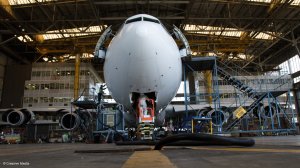National carrier South African Airways (SAA) has posted an operating loss of R374-million for the year ended March 31, 2014, attributing its fragile balance sheet to impairments dictated by its Long-Term Turnaround Strategy (LTTS) and lacklustre profits from intercontinental operations.
SAA, which delayed the release of its full-year results by almost six months, outlined on Friday that its international operations remained loss-making, with this division having increased its operating losses by R235-million to R1.6-billion.
The airline was reviewing the viability of its long-haul routes and had already announced that it would, from March 31, no longer fly between Johannesburg and Beijing, China.
The airline was also looking to “reconfigure” loss-making routes between Johannesburg and Mumbai, the US and Senegal.
COST IMPLICATIONS
SAA’s profits were, meanwhile, further dampened by the ongoing impact of a weakened currency and high fuel prices during the year under review.
“The volatility of the rand saw a decline in value of over 34% during the 2013/14 financial year, which placed local airlines at a disadvantage, considering that nearly 60% of all input costs are priced in foreign currency and foreign exchange revenues represent only 40% of gross income,” commented acting CEO Nico Bezuidenhout.
Despite this, the carrier succeeded in reducing its cost per available seat by 5%, from $0.70 in 2013 to $0.60 in the period under review, yielding cost-containment savings of R453-million.
It further realised net hedging gains of R76-million, compared with hedging losses of R84-million in the prior year.
IMPAIRMENTS
Bezuidenhout added that another significant cost to the company were impairments relating to aircraft – a “critical” element of the LTTS that would see the replacement of the airline’s existing wide-body fleet with the new-generation, fuel-efficient twin-engine aircraft.
In this regard, SAA’s seven wide-body aircraft had to be revalued to take into account their expected remaining useful life, resulting in an impairment of R782-million, as well as an additional R192-million write-down on related spares and inventory.
“Further impairments were recognised relating to the delivery of four new Airbus A320 aircraft. These form part of a legacy agreement for 20 aircraft, dating from 2002, which was renegotiated in 2009.
“However, the contract provides for [yearly] escalations, which resulted in the purchase price exceeding the market value at date of delivery and a further impairment of R369-million,” he said.
Bezuidenhout added that similar impairments were expected on future deliveries on this contract; the remaining capital commitment of which was R822-million.
LOCAL STRONGHOLD
The SAA group’s domestic operations had remained profitable in the 2014 fiscal period, with 10% year-on-year growth in its profit contribution, from R722-million to R791-million.
Regionally, African routes performed “positively”, with a 17% year-on-year increase, from R648-million in 2013, to R761-million in 2014.
A solid performance by the domestic division drove overall growth in revenues by 12%, from R27.1-billion in 2013, to R30.3-billion in the period under review.
LTTS REVIEW
Bezuidenhout outlined that a full review of the LTTS was currently under way to ensure “revalidation” in line with the current needs of the business, given the airline’s failure to adequately implement the plan.
“The shareholder and newly constituted board have made it clear to management that the 90-day action plan’s primary outcome must be the resumption of LTTS implementation.
“The plan period ends on March 24, [after which] implementation of a revalidated LTTS will be resumed, albeit trailing 16 months behind schedule,” the airline said in a statement.
Under the plan, which was guided by unimplemented aspects of the LTTS, SAA had “reconfigured” loss-making aspects of its intercontinental network, as well as implemented mitigating actions to minimise customer inconvenience along with considered potential commercial gains.
As part of this strategy, SAA had increased regional frequencies between Johannesburg and several key, high-volume regional destinations, including Mauritius, Zambia, Zimbabwe and Mozambique, besides others.
A full contract review was under way, with “onerous” agreements being examined. This included all supplier agreements, including a review of aircraft leasing contract positions.
Moreover, SAA procurement had been mandated to realise a further 10% to 15% benefit on existing and new supplier agreements, while an immediate freeze on headcount was implemented, with a moratorium on any new appointments.
“Full implementation of the 90-day action plan, leading into LTTS implementation, will return the company to relative stability and ultimately sustainability in the medium- to long-term,” the group stated.
EMAIL THIS ARTICLE SAVE THIS ARTICLE
To subscribe email subscriptions@creamermedia.co.za or click here
To advertise email advertising@creamermedia.co.za or click here










